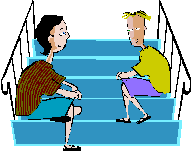What Are Schools Doing to Address Societal Problems?
(3.6)
Many schools have taken innovative steps over
the past decade to address problems that have impact student's lives. Various
programs that address social problems have been created, and they are expensive.
What social services should be delivered through public schools has been debated
over the years. Some people feel that state funding should cover health, mental
health, and even family planning clinics.
A Few Intervention
Programs....

Peer counseling
The aim of intervention programs is to address
the behavioral, social and academic adjustment of at-risk children and
adolescents. Peer counseling is an intervention program that is often monitored
by a school counselor or a trained adult. Students are "trained" to counsel
other students. Conflict mediation is often used through peer counseling in
order to help students resolve their problems. Evidence indicates that both peer
counselors and students experience a greater ability to deal with problems. Peer
counseling is often combined with cross-age tutoring. In this learning situation
the older students counsel the younger ones on such topics as drugs, peer
pressure, delinquency, dropping out of school, suicide, smoking and many other
social issues. This kind of mentoring is usually a positive experience for all
students involved.
Full-service schools
At full-service schools, students and families
receive health screening, psychological and drug prevention counseling, parent
education, and family planning information. These schools are usually found in
low-income urban areas.
School-based interprofessional case
management
In responding to the needs of at-risk
students, this approach forms a partnership between home, school and the
community. Professionally trained case managers work directly with teachers, the
community and the family to coordinate and deliver appropriate services for
at-risk students and their family.
Some other
things....
Compensatory Education
These are federally funded programs designed
to meet the learning needs of at-risk students, the largest of which is called
Title 1. Title 1 was launched in 1965, and designed to improve basic skills of
low-ability students from low-income families.. This was called Chapter 1
between 1981 and 1994. The Educational Excellence for All Children Act of 1999,
called for dramatic new steps to improve education for at-risk students. This
act called for an end to "social promotion". Students who participate in Title 1
programs are usually taught through "pull-out" programs. The effectiveness of
these programs is inconclusive. Studies show a positive effect on student's
achievement during the early grades, but these gains decrease during the middle
school grades.
Alternative Schools
Alternative school
is usually a smaller school separate from the regular school. It is organized as
a school within a school. These schools provide remedial
instruction and individualize counseling.
Activity 1
1. What Intervention programs are at your school and how effective are
they?
2. What Title 1 programs are visible and implemented at your school? Do
they work? Explain your answer.
3. Would Internal Suspension be considered an alternative school? Why
or why not? |
Vocabulary
Peer counseling-an arrangement
whereby students, monitored by a school counselor or teacher, counsel one
another in such areas as low achievement, interpersonal problems, substance
abuse, and career planning.
Full-service schools-schools
that provide students and their families with medical, social and human
services, in addition to their educational programs.
School-based inter-professional case
management-an approach to education in which professionally trained case
managers work directly with teachers, the community, and families to coordinate
and deliver appropriate services to at-risk students and their
families.
Compensatory education
programs-federally-funded educational programs designed to meet the
needs of low-ability students from low-income families.
Alternative school-a small,
highly individualized school separate from a regular school;designed to meet the
needs of students at risk.
School-within-a-school-an
alternate school (within a regular school) designed to meet the needs of
students at risk.

